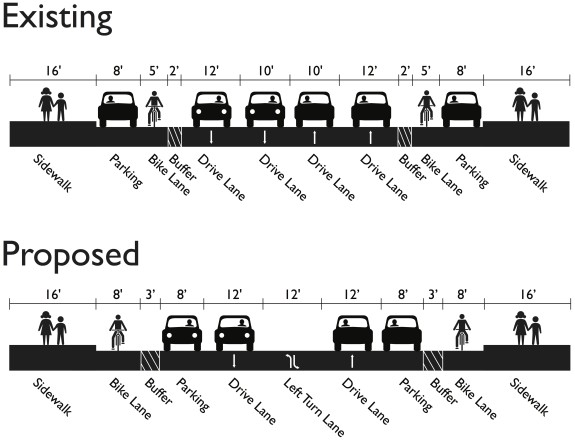
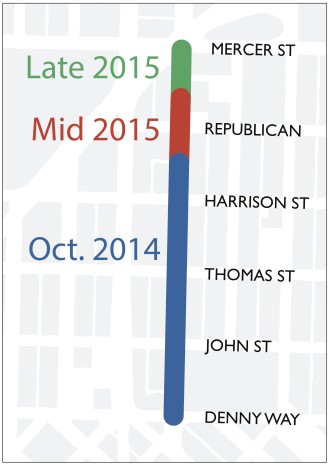 When the state finally finishes its Hwy 99 utility work that has torn up half of Dexter Ave near Harrison Street in recent months, they will put the road back together and repaint it. But instead of returning the street to its former dangerous design, which was the scene of more than its share of death and injury, the city plans to give the street a safer makeover.
When the state finally finishes its Hwy 99 utility work that has torn up half of Dexter Ave near Harrison Street in recent months, they will put the road back together and repaint it. But instead of returning the street to its former dangerous design, which was the scene of more than its share of death and injury, the city plans to give the street a safer makeover.
Working on a tight budget, planners propose changing the current bike lanes into much wider parking-protected bike lanes and redesigning the street to have one lane in each direction plus turn lanes. Having fewer lanes to cross when making a turn and having a dedicated lane to wait while making turns should make the street safer and less stressful for everyone.
In the cases of several people who have been struck and killed or seriously injured on this stretch of Dexter, including Mike Wang in 2011 and Brandon Blake in 2013, people making left turns gunned it to try to make it through a break in the two lanes of oncoming traffic, but did not see the person riding in the bike lane (we have a follow-up story about Blake coming soon, so stay tuned).
This section of Dexter carries only about 10,700 vehicles each day, including about 1,100 bikes (bikes make up nine percent of vehicle traffic). That is far fewer motor vehicles than the former highway-style street was designed to carry. As we noted in our previous post, having a dramatically over-designed street is dangerous and stressful for everyone. Indeed, SDOT data shows that only 41 percent of people driving northbound on Dexter obey the speed limit. Southbound, it’s 52 percent.
There have been 80 reported collisions on this stretch of street since 2011. More than a third of them involved someone biking or walking.
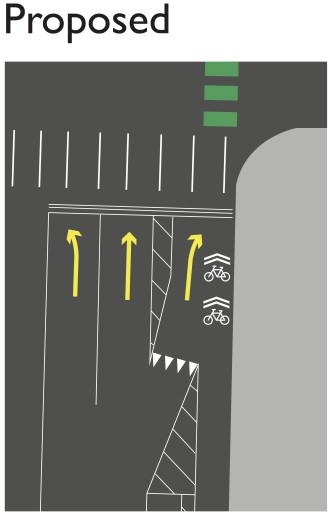
However, being a low-budget project, the city’s plans for the street fall short of the ideas I threw around in my previous post. For example, instead of having separated bike and motor vehicle turn signals at intersections, the design follows the NACTO bike lane guide for streets with protected bike lanes and combined turn lanes. This means the protected bike lane will turn into a combined right turn and bike lane at each intersection. People turning right in a car will be instructed to yield before entering the turn bay.
Since many intersections along the street do not have signals, adding them would have been rather expensive. But the tradeoff is that these combined turn lanes will not be completely comfortable for people of all ages and abilities, and they depend on people driving to actually obey the yield instructions in order to be safe. Here’s an illustration from the NACTO guide showing what it might look like (imagine there is also a left turn lane):
The combined lane design also reduces the potential safety improvements for people walking, who will still need to cross four lanes to get from one side to the other. The street will still be built to handle far, far more car traffic than it will actually carry.
Planners say they hope to add bike signals in a future phase.
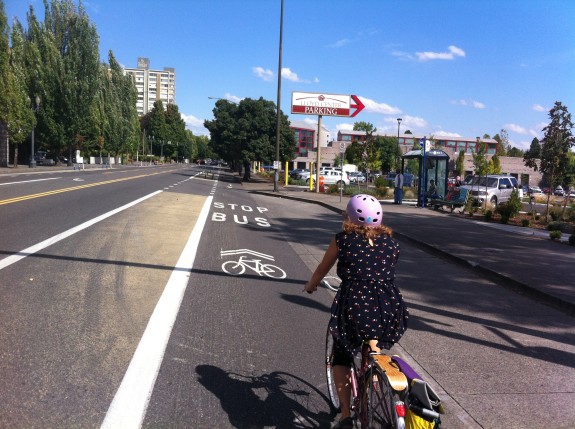
Buses will also continue to pull to the curb, which means they will now need to pull across a parking lane and the wider bike lane to serve stops. There will not be bus islands like on the section of Dexter north of Mercer, though they might also be added in a future phase of work.
The upgrades will be rolled out over the course of a year potentially starting this month. But continued Mercer construction will prevent them from reaching the existing Dexter bike lanes until late 2015.
So, it’s exciting that the city and state are not going to simply repaint the dangerous previous design. And for a project with very little budget, this will likely be a safety and comfort improvement. But we can do better, and it’s worth investing more and being a bit more creative to help Dexter become the truly great people-powered entrance into downtown that it should be.
A creative open house
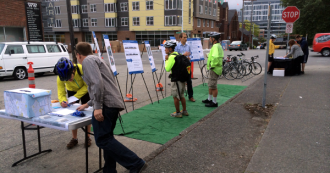
One highlight to come from this project is not even about the design itself. The city needed to hold an open house to let users know about what they had planned, but their low budget made a typical indoor open house (and the promotion needed to get people there) difficult. So instead, they set up an open house right on the street.
They drew somewhere between 40 and 60 people in three hours, which would be a pretty good turnout for a typical and much more expensive indoor open house (assuming there was not big controversy that fueled a larger crowd). And being on the street itself can help people visualize the changes they propose.
It’s great to see SDOT experiment with outreach efforts to reach people more effectively and in different ways. I’d love for this to become more standard for road redesign projects.

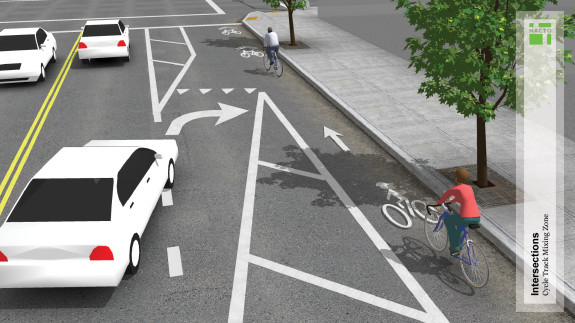







Comments
31 responses to “Dexter protected bike lane plans include shared turn lanes, bus stops”
Oh my. That NACTO “Cycle Track Mixing Zone” picture looks pretty dangerous. I wouldn’t want to approach that mixing zone without a steel cage and air bags.
Functionally they’re pretty similar to the current configuration, assuming SDOT uses an appropriate design speed for the downhill section (to ensure that both approaching cyclists and motor vehicles can see each other in time to react safely). If you’re comfortable riding in the bike lane now, the intersections will probably feel the similarly comfortable.
The only theoretical improvement is that it should be easier to tell when a car is planning to make a right turn, as opposed to now when you’re left guessing whether they forgot to signal or not. You’ll still need to be just as attentive at intersections (and the intersection approach), and it will be harder to pass to the left of right-turning cars.
Any idea what a sufficient “area of visibility” would be to make this work? 50 meters? 100? (E.g. the whole block?)
Seems super scary to me – but maybe I’m missing something.
How is this not likely to end up with drivers hitting cyclists the drivers claim “came out of nowhere”?
Yeah, I look forward to turning motorists yielding to cyclists never, as is currently the case.
Nearly every single person who drives on 2nd ave has lost the ability to discern the cryptic “No Turn On Red” signs just a couple weeks into the bikeway’s existence. I’m pretty sure the only thing that would keep automobile drivers from crashing into other road users is a very thick wall.
I don’t see a protected bike lane in any of those proposed designs.
Screw the shared turn lane! Why does the biker always have to sacrifice their safety for convenience of vehicles. It should be difficult, slow, and costly to drive in city! Not to mention its an absolute nightmare to ride up to and across Mercer st into downtown.
Lets borrow some funds from that failed bertha project that is bleeding the city dry!
The alternative to requiring motorists to merge right for right turns is to have separate signal phases for through cyclists and turning motorists, like on 2nd Ave. Otherwise, you have through traffic to the right of right-turning traffic, which violates the most fundamental rules of traffic engineering.
But installing signals is expensive, and providing a separate signal phase for through bicyclists vs. turning motorists gives a shorter green phase for all users. (There are only so many seconds in a minute… six signal phases always means more wait time than four signal phases.) That makes bicycling slower and less convenient, too, which can definitely deter mode share.
Shared turn lanes work fine almost everywhere, and in requiring drivers to yield unconditionally are more convenient for cyclists and pedestrians than adding traffic signals at every intersection. The last thing this town needs is more traffic signals.
I agree that it will probably work fine. But it could be better. It falls a bit short of that 8-80 (90? 100?) goal we should be aiming for. Would you feel comfortable sending an eight-year-old biking down this street on their own? If not, then we haven’t quite gotten there yet.
It is legal for 8 year olds (and 90 year olds) to ride on that 16 ft. wide sidewalk. Not that crossing in a cross walk is necessarily very safe either.
While “all ages, all abilities” does seem like a reasonable ideal, there are limits to how far one can go. Since this project is nearly free (given that the road needs to be redone anyway) this is a case where ” Perfect is the enemy of good” really does apply. (in contrast to some door zone bike “lanes” that are arguably worse than nothing at all) .
I’d rather have this project get done quick and make an incremental improvement, and then focus on making an 8-80 facility that connects to the Westlake Cycle Track. Prioritize our investments on making contiguous facilities of the same level of service.
Do they work when cyclists are effectively invisible (tucked behind a row of SUV’s) before the intersection?
It seems like our new mayor is getting more done. Dexter needed fixing for a long time as it has proven to be a death trap in the past. Always remember that you are invisible on a bike, unless you have ultra bright flashing lights, especially in the day time. Don’t die because you are obeying the flashing light law. Always be ready to dodge the blind, stupid, cell phone talking drivers out there. Think of alternative safer routes if you have the time. Think about your speed in the city. It is not hard to reach 30 to 40 mph on Dexter but cars really don’t expect bikes at that speed and bikes don’t manuever so well or brake so well at that kind of speed.
I mostly stopped going through town and onto Dexter. Instead I battle along the waterfront until I get to Myrtle Edwards Park and than take trails most of the way to the U District. Sometimes I use the road and sometimes the paths through the waterfront always keeping safety in mind as I go. It is a little longer going my way but I have a lot less cars near to me overall, and that reduces the odds of getting hit.
Are mixing zones the best we can do?
No: http://www.protectedintersection.com/
This concept is nice for signalized intersections, but doesn’t really apply to the unsignalized intersections on Dexter. It would in fact be less safe.
Without signal phases preventing right turns, you would likely be right :/
That mix zone of turn lane for drivers, cyclists can go straight? On Dexter? I ride from just north of Mercer to Bell almost every day and I think that is a terrible, terrible idea. Especially at Denny/Dexter. I do not believe drivers in this area will suddenly go “ok, great! I’ll wait behind the cyclist in front of me who is blocking my free-right on red turn, no problem. Even though there is nothing but paint to the left of the cyclist (even if cyclist is ‘taking the lane’) so I have no temptation to just drive around them and turn anyway. And I certainly won’t try to make a right turn in front of a cyclist whom I have just overtaken to make a right turn on a green light. After all, that cyclist has the right of way.”
Yes, that’ll happen.
I would go back to riding up Fairview with that configuration no problem.
Sharrows mean nothing.
In fact, this is kind of the opposite of the intersection just south of Denny/Dexter, where it turns into 7th. The drivers coming from the right have a yield sign to oncoming traffic, and the bike lane gets scrunched between the shoulder/right turn lane and the left motor vehicle lane. Drivers merge all over the place with almost no regard for bicycle traffic – this is exactly that kind of merge zone. In which drivers completely destroy the plastic poles SDOT keeps having to re-install each year.
This doesn’t apply to the Denny/Dexter intersection. No changes are proposed to the right-turn pocket from SB Dexter to Denny.
There are two signalized intersections (Harrison and Republican) that this project is revising. While there is the possibility of cars squeezing around by knocking over the plastic poles, I expect that this will still be an improvement (albeit minor) over the current configuration. I’m planning to aggressively take the lane when entering the mixing zone. If you’re feeling nice you could swing all the way to the left to allow bicycles or vehicles turning right to make that turn movement while the light is red.
Getting rid of right-on-red would definitely resolve a lot of issues, though. For both people on foot in crosswalks and on bikes.
I’ve only had one driver get pissed off at an intersection where bicyclists can go straight while motor vehicles have to turn right. It was at the intersection of 35th and Stone, and when the driver started honking, I just pointed to the big sign that said “Right lane Right turn only EXCEPT BICYCLISTS”. The guy looked pretty sheepish, and five seconds later the light changed and we both got on our way.
I’m much more leery of streets where bicyclists can’t go straight from the right lane, because then one has to change lanes constantly.
Oh, look, another design where bus stops halt an entire direction of road traffic on an arterial… including the bike lane as passengers pour out.
My first concern is getting hit by left turning motorists, especially northbound (exactly the situation where Mike Wang was killed). As they approach the intersection, they may not think to look beyond the parked cars to a cyclist coming toward them, especially if the parked cars block the view of the cyclist.
My second concern is cross traffic at intersections without traffic signals. It is already common farther north on Dexter (and many other places) for cars to pull into the bike lane as they stop, since they cannot get a good view of cross traffic from behind the stop sign. Legally they should stop behind the stop sign, then proceed slowly into the intersection until they have a good view of cross traffic. Often I see cars that don’t slow down until they are well into the intersection, just short of being in the path of cars, but blocking the bike lane. I have had cars pull right in front of me, because they don’t start to look until they are in the bike lane. With the bike lane to the right of the parked cars, it makes the problem even worse.
I think that putting bicycles behind parked cars only serves to make them less visible, and more vulnerable to drivers that don’t think to look for them. I think the current configuration is better than the new proposal.
I have the same reservation about being hidden behind the parked cars. My only hope is that with an actual turn lanes people won’t be so obsessed with shooting the gap as exists with the current left lane of travel.
Your other point is interesting, left turning cars coming out of the side streets will have a tendency to poke all the way out to the edge of the parked cars so they can see to make the turn. Even if they do stop at the line then proceed forward to get a line of sight they may get stuck in the middle of the bike lane waiting for a gap. It really seems to me that a lot of the turning traffic in this region is actually people doing cut throughs to save 30 seconds. The type of people that tend to drive aggressive and shoot into any gaps without considering all users.
Please email the project contact ([email protected]) and request that SDOT design the amount of parking clear zone both before and after the intersections such that a bicycle travelling at downhill speeds will be visible, and so that vehicles turning on to Dexter have a clear view of traffic so that they do not need to block the bike lane to complete their turn. In the initial design the parking clear zone was shown based on the NACTO standard plans, which assume a flat road, and no parking removal was shown past the intersections.
I don’t know which calculation will end up controlling the clear zone required before the intersection (bicycle design speed to avoid conflict with cars entering the mixing zone, or vehicle design speed on Dexter to ensure clear sightlines for vehicles attempting to turn on to Dexter without blocking the bike lane).
For the downhill segments of this project, SDOT needs to use a bicycle design speed of 25mph at a minimum.
The parking removal also needs to be on both sides of the intersection to avoid the behavior you describe of vehicles from the intersecting streets blocking the bike lane when attempting to turn on to Dexter.
I agree with all of these comments. In general, I dislike the idea of being concealed by parked cars before entering an intersection. The amount time a left-turning driver will have to see me will depend on (1) my speed and (2) how close to the intersection the cars are allowed to park. Clearly the path to greater mode share is making novices feel safe and one way to do that is to put physical barriers, like a line of parked cars, between bikes and cars. But it would be a shame to compromise the actual safety of existing users, which depends on visibility and reaction time, for the uninformed “feeling” of safety we attribute to hypothetical novice users.
I think it’s better to email that contact and ask that either:
* parking end way before the intersection to improve bike visibility
OR
(since that’s not going to happen)
* the design gets redone to put the bike lane back in the street where you’re less likely to get killed by right or left hooks (which we know *already* are deadly in this area)
The sharrows in the mixing zones appear misplaced — the goal is not for cyclists to hug the curb so that turning motorists can cut them off, but for cyclists and motorists to share the zone sequentially, one after another. The sharrows should be centered in the effective width of the lane in the mixing zone, to make it clear to motorists that bicycles are NOT expected to cower to the right here.
Also, while they’ve technically been around for years, very few Washington motorists have any idea what shark-teeth yield lines are. They’re not included in the Washington Driver’s Guide or the driving exam, and most people don’t encounter them frequently when driving. The yield requirement should be posted with signs, not just shark-teeth lines, if SDOT wants any significant level of compliance.
The standard shared lane marking is 40-inches wide, and MUTCD says the center of the sharrow should be no less than 48 inches from the curb.
That means the gap to the right of the sharrow should be no less than 28 inches, roughly 3/4 the width of the sharrow itself.
As shown, the design does not comply with MUTCD design guidance, which means it also does not comply with the Bicycle Master Plan Update adopted this year.
[…] Changes here: Seattle Bike Blog outlines options for improving the pedestrian and bicycle experience across the Ballard Bridge. A new multi-use trail in Arboretum will give the Central District its own “Green Lake”. Another pot shop opens in Seattle in the Central District, say “hello” to Uncle Ike’s. SDOT is planning a revised Dexter Avenue from Denny Way to Mercer Street, now with full protected bike lanes. […]
[…] closed overnight Monday and Tuesday between Denny and Mercer so crews can repaint the street with a new complete streets design that includes wide parking-protected bike lanes and a center turn […]